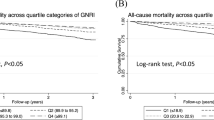Abstract
Introduction
Malnutrition is a common complication in hemodialysis (HD) patients and it is related to morbidity and mortality. Although a gold standard method for diagnosis of malnutrition is not available, serum albumin, body weight and height are commonly used and are included in the calculation of the Geriatric nutritional risk index (GNRI). Recently the association between GNRI and mortality in chronic HD patients has been documented in Asian populations. Our aim was to examine the relative reliability of the GNRI as a mortality and morbidity predictor in an Italian HD cohort.
Methods
We prospectively examined the GNRI of 753 maintenance HD patients aged 65.7 ± 14.1 years, 457 males, included in the Riscavid cohort, and followed them up for 84 months. Predictors for all-cause death were examined using Kaplan–Meier and Cox proportional-hazards analyses.
Results
Low GNRI was significantly associated with signs of wasting, i.e. low Body mass index, hypoalbuminemia, low normalized protein catabolic rate. Patients within the lowest GNRI quartile had a significantly lower survival rate than those in the 2nd to 4th quartile (p < 0.001). Multivariate Cox proportional-hazards analysis demonstrated that the lowest quartile of GNRI was a significant predictor of case mix adjusted all-cause mortality (HR 1.72; CI 1.35–2.18, p < 0.001).
Conclusions
These results demonstrate that low GNRI (<92) is associated with malnutrition and is a strong predictor of overall mortality in HD patients. However, cardiovascular events did not differ among the GNRI quartiles. A low GNRI score can be considered a simple and reliable marker of malnutrition and predictor for mortality risk in Caucasian HD patients.

Similar content being viewed by others
References
Foque D, Kalantar-Zadeh K, Kopple JD et al (2008) A proposed nomenclature and diagnostic criteria for protein-energy wasting in acute and chronic kidney disease. Kidney Int 73:391–398
Bonanni A, Mannucci I, Verzola D et al (2011) Protein-energy wasting and mortality in chronic kidney disease. Int J Environ Res Public Health 8:1631–1654
Kovesdy CP, Kalantar-Zadeh K (2009) Why is protein–energy wasting associated with mortality in chronic kidney disease? Semin Nephrol 29:3–14
Pupin LB, Ikizler TA (2004) Assessment and monitoring of uremic malnutrition. J Ren Nutr 14:6–19
Yamada K, Furuya R, Takita T, Maruyama Y, Yamaguchi Y, Ohkawa S, Kumagai H (2008) Simplified nutritional screening tools for patients on maintenance hemodialysis. Am J Clin Nutr 87:106–113
Kobayashi I, Ishimura E, Kato Y et al (2010) Geriatric nutritional risk index, a simplified nutritional screening index, is a significant predictor of mortality in chronic dialysis patients. Nephrol Dial Transpl 25:3361–3365
Park JH, Kim SB, Shin HS, Rim HB (2012) Geriatric nutritional risk index may be a significant predictor of mortality in Korean hemodialysis patients: a single center study. Ter Apher Dial 16(2):121–126
Panichi V, Rizza GM, Paoletti S et al (2008) Chronic inflammation and mortality in hemodialysis: effect of different renal replacement therapies. Results from the RISCAVID study. Nephrol Dial Transpl 23(7):2337–2343
Panichi V, Maggiore U, Taccola D et al (2004) Interleukin-6 is a stronger predictor of total and cardiovascular mortality than CRP in hemodialysis patients. Nephrol Dial Transpl 19:1154–1160
Charlson ME, Pompei P, Ales KL, MacKenzie CR (1987) A new method of classifying prognostic comorbidity in longitudinal studies: development and validation. J Chronic Dis 40:373–383
Stenvinkel P, Heinburger O, Lindholm B (2004) Wasting, but not malnutrition predicts cardiovascular mortality in hemodialysis patients. Nephrol Dial Transpl 19(9):2181–2183
Kalantar-Zadeh K, Block G, Humphreys MH, Kopple JD (2003) Reverse epidemiology of cardiovascular risk factors in maintenance dialysis patients. Kidney Int 63:793–808
Stenvinkel P, Heinburger O, Paultre F et al (1999) Strong association between malnutrition, inflammation and atherosclerosis in chronic renal failure. Kidney Int 55:1899–1911
Kalantar-Zadeh K, Kopple JD, Humphreys MH, Block G (2004) Comparing outcome predictability of markers of malnutrition–inflammation complex syndrome in hemodialysis patients. Nephrol Dial Transpl 19:1507–1519
de Musert R, Grootendorst DC, Boescheten EW et al (2009) Subjective global assessment of nutritional status is strongly associated with mortality in chronic dialysis patients. Am J Clin Nutr 89:787–793
Kalantar-Zadeh K, Kopple JD, Block G, Humphreys MH (2001) A malnutrition-inflammation score is correlated with morbidity and mortality in maintenance hemodialysis patients. Am J Kidney Dis 38:1251–1263
Baumeister SE, Fisher B, Doring A et al (2011) The geriatric nutritional risk index predicts increased healthcare costs and hospitalization in a cohort of community-dwelling older adults: results from the MONICA/KORA Augsburg cohort study, 1994–2005. Nutrition 27(5):534–542
Chinen J, Shearer WT (2008) Secondary immunodeficiencies, including HIV infection. J Allergy Clin Immunol 121:S388–S392
Koyama H, Fukuda S, Shoji T et al (2010) Fatigue is a predictor for cardiovascular outcomes in patients undergoing hemodialysis. Clin J Am Soc Nephrol 5(4):659–666
Fiedler R, Dorligjav O, Seibert E, Ulrich C, Markau S, Girndt M (2011) Vitamin D deficiency, mortality, and hospitalization in hemodialysis patients with or without protein-energy wasting. Nephron Clin Pract 119(3):c220–c226
Raphel KL, Wei G, Greene T, Baird BC, Beddhu S (2012) Cognitive function and the risk of death in chronic kidney disease. Am J Nephrol 35(1):49–57
Bossola M, Tazza L, Giungi S, Luciani G (2006) Anorexia in hemodialysis patients: an update. Kidney Int 70(3):417–422
Conflict of interest
No conflict of interest declared.
Author information
Authors and Affiliations
Corresponding author
Rights and permissions
About this article
Cite this article
Panichi, V., Cupisti, A., Rosati, A. et al. Geriatric nutritional risk index is a strong predictor of mortality in hemodialysis patients: data from the Riscavid cohort. J Nephrol 27, 193–201 (2014). https://doi.org/10.1007/s40620-013-0033-0
Received:
Accepted:
Published:
Issue Date:
DOI: https://doi.org/10.1007/s40620-013-0033-0




